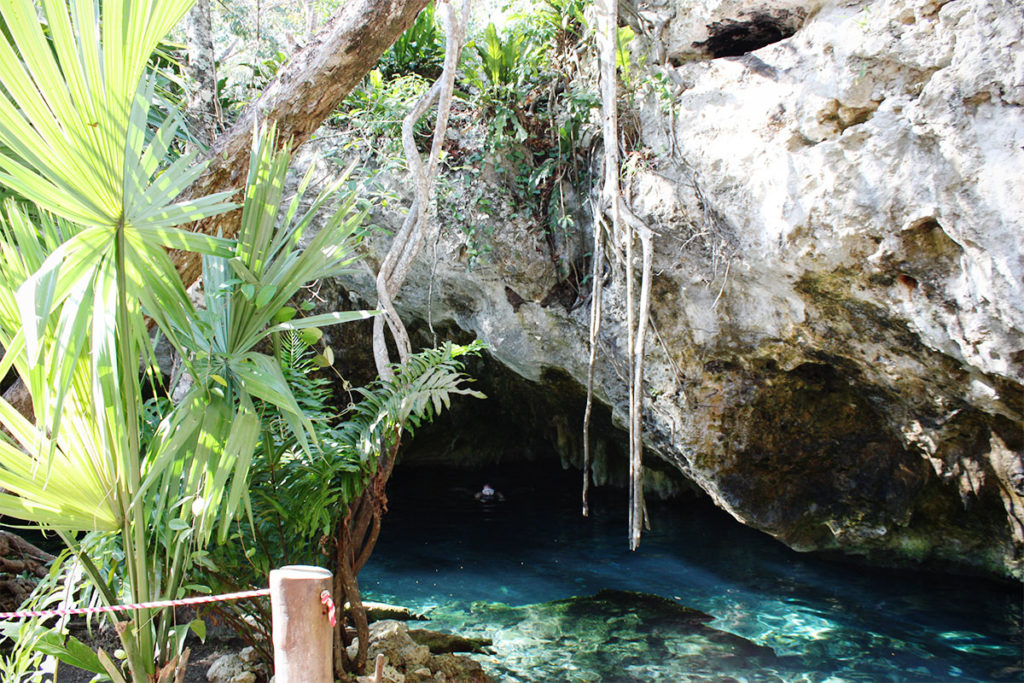
In case it wasn’t obvious from my Tulum travel diary, a highlight of our trip was undoubtedly visiting several of the limestone sinkholes known as cenotes that are dotted across the Yucatan peninsula. Filled with fresh water, these swimming holes are beautiful, fun and restorative. Here’s a breakdown of the four we visited and why you should add them to your Tulum itinerary…
The first cenote we stopped at was Cenote Multum-Ha, near the Coba Ruins. After a day of exploring ancient pyramids in the heat of the jungle, this underground cenote was the perfect place to cool off. A couple of miles off the main road, it felt like we were driving to the middle of nowhere, and when we arrived there was only one Mexican family there – the complete opposite of Gran Cenote, which is closer to Tulum and the most popular cenote in the area with tourists. After showering (a mandatory requirement before entering any cenote) we walked down a rickety wooden spiral staircase which opened up into an underground decking area. We left our shoes and towels in a corner of the deck and entered the 30 foot wide cenote. The water was cold but not freezing, and criss-crossing guide ropes helped us navigate, particularly when the only light source cut out while we were in the water. It didn’t last long though!
The popularity of Gran Cenote is reflected in the entry fee (not much, but more than smaller cenotes) and also in how crowded it can get. We went there straight after Cenote Multum-Ha, an hour or so before it closed for the day, and there were still plenty of people there. Gran Cenote is beautiful, a mix of open air and enclosed spaces so it’s definitely worth visiting, but avoid the middle of the day, when it’s most crowded. There are lockers, snorkeling gear for hire and decent toilet and shower blocks here, and there was even a section of the cenote blocked off for a resident family of turtles.
After taking a refresher dive class and then snorkeling in the two cenotes mentioned above, we knew we’d be silly not to give cenote diving a try, which is how we ended up at Dos Ojos. Dos Ojos is one of the largest underwater systems in the world and is split into multiple cenotes. Very popular with divers and snorkelers, it’s a good entry level cenote to try cavern diving. Different from cave diving, cavern diving is still underground but the exits are always clearly visible and never more than 60 feet away.
Having only dived in open water before, I was concerned that I would feel claustrophobic in such a space but after a couple of minutes underwater, it felt no different than when we had completed a night dive in Thailand. Relying on torches and a guideline, we navigated the cavern system alongside our instructor. There were stalactites and stalagmites to navigate around, and our first dive was challenging. The second dive took us to the Bat Cave, an incredible underwater cave one can surface in and it contains, you guessed it, bats, hundreds of bats. Bobbing around in here was amazing and while we didn’t stay long, it was an experience I’ll remember for a long time to come.
The final cenote we went to was Cenote Escondido, on the outskirts of Tulum. Much smaller than Gran Cenote or Dos Ojos, Escondido belongs to the owners of Cenote Cristal across the other side of the highway, and it was there that we had to pay a small entrance fee before accessing it. When we arrived around 11am, we were the only ones there and while this didn’t last long, there were never more than 20 or so people at this open water swimming hole in the jungle. I’ve mentioned it before but it felt restorative swimming alone from one end to the other before grabbing my snorkel and fins and spotting schools of tiny fish and even divers further below. The facilities here were non-existent but we planned ahead and brought a picnic of empanadas, fruit and plenty of water with us.
Having a car was indispensable for getting to the smaller, lesser known cenotes, but there are hundreds throughout the region so it wouldn’t be hard to find one within easy cycling distance from Tulum.
I don’t know if I could pick a favourite as each cenote was different, but I definitely preferred the smaller ones, particularly as I felt better able to keep an eye on our belongings and also because it’s more magical when you don’t have someone accidentally kick you in the face as they swim past. It’s easy to get distracted though – the colour of the water, the level of visibility and the rock formations are a thing of beauty.
So there you have it – a rough guide to some of Tulum’s cenotes and why you should visit them!



